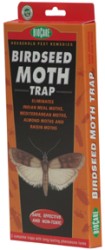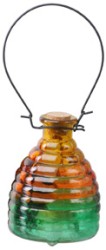It’s that time of year again when days get longer, temperatures get warmer, and bugs seem to come out of no where. Are you freezing your seed mixes and pellets for at least 24 hours before opening them? You should – especially during spring and summer – unless you want to end up with fruit flies and pantry moths!
We’ve all been there at least once in our time as bird owners; You crack open a brand-new, never frozen bag of bird food because you ran out the night before, seemingly all of a sudden. There’s no time to freeze it because your birds are hungry, screaming, and threatening to call PPS (Parrot Protective Services). Not too long after you’ve soothed the tempers of the feathered dragons in your home, you see just one little moth. You try not to think anything of it… until you notice five or six more a few days later. If you don’t take care of a pantry moth problem as soon as it begins, you’ll soon not be able to have a moment of peace without a moth buzzing around your head!
Pantry moths are commonly found in all kinds of bird seed mixes and pelleted foods. Most tend to be introduced to the food once the packages are stored in a warehouse. The best first step to avoiding a pantry moth infestation is to buy bird foods that have been sealed by the manufacturer in durable packaging, then freezing the food immediately. While shopping from the bulk seed bins may save you a few nickels in the short term, the bins are rarely air-tight and are easily infiltrated by moths who get insid e and lay their eggs. Refrigerating or freezing bird food, whether sealed or from bulk, before opening will inactivate the eggs and render them unlikely to hatch, curbing the issue before it begins. While the eggs and larvae are edible to your parrots, and some birds may even enjoy eating them, the uneaten larvae quickly go from nuisance to moth infestation.
e and lay their eggs. Refrigerating or freezing bird food, whether sealed or from bulk, before opening will inactivate the eggs and render them unlikely to hatch, curbing the issue before it begins. While the eggs and larvae are edible to your parrots, and some birds may even enjoy eating them, the uneaten larvae quickly go from nuisance to moth infestation.
Bird Cages 4 Less carries two kinds of moth traps to use in different areas of your home. If your pantry moth problem is localized to where you store your bird food, you can use the Bird Seed Moth Trap to help regain control of the area. For infestations that have spread to the kitchen, or originated in the kitchen, you can use the Flour Moth Traps. Both traps work in the same manner – a pheromone which attracts male moths lures them into the trap, where they stick to an adhesive. By eliminating the males from the population, there will be no mating or eggs laid – and eventually your problem will resolve on its own. During this time, keep bird foods in the refrigerator as well as any human grains, flours, or similar products.
Do your birds enjoy eating fruit? During the winter, I never have a problem serving up a bowl of defrosted berries or opening a can of tropical fruits for the birds. During the spring and summer, however, I sometimes hesitate; What if this attracts a bunch of fruit flies? An unfortunately reality is that most fruits, and even dried fruit mixes made for parrots, are also delicious to flies! Rather than never allowing your feathered friends to indulge in a new slice of watermelon on a scorching summer day, you can invest in a few fruit fly traps to keep any flies under control.
While regular fly strips are highly effective and very inexpensive, you will definitely not want to use one in an area where your parrot will be loose. Even if your bird is not flyer, you’ll not want to be rushing off to the vet to have them help you remove an adhesive fly strip from your bird’s feathers! Use of these strips should be strictly limited to areas of the home where your bird will never, ever have access.
For all other areas of the home, we have Glass Fruit Fly Traps, and replacement lures for them! Admittedly, they are attractive traps with colorful glass and resemble a lantern or stained glass pot. The fruit fly bait lures the flies inside of the pot, where they become trapped and cannot escape through the narrow opening at the top. You’ll be shocked how many little buggers can be caught with just a single glass trap in the room! The product is completely safe and non-toxic and works without pesticides.
For a bug problem that spreads to your bird cages, you’ll want to start with a deep clean, which will involve putting your bird on a playstand or in their travel cage for a few hours. If possible, take the cage apart and move it outside to be sprayed with a hose and dried in the sun. Using dilute bleach water and a cage scrubbing sponge will remove any caked on food, which attracts bugs, and any eggs or larvae, which will continue the pest life cycle. If this is not possible, do your best to scrub the cage while assembled! Then, you can follow up with a preventative application of Mango Brand Natural Control Bug Spray. Having used this product myself in the past, I can say that I believe it is only effective on minor problems and will not treat or control and infestation. This should be used as a preventative or maintenance measure – not as a cure for a rampant bug problem!
The biggest focus during pest season should be keeping cages and play areas extra clean and sanitary, so there isn’t food to attract bugs in the first place. Next, making sure all foods are frozen for at least 24 hours before use. And lastly, ensuring that all products to treat or control an infestation are safe for use around your birds. All of the products mentioned here, and all those carried by Bird Cages 4 Less are 100% safe – and effective! Check back in with us all spring and summer long for more tips on how to keep your companion parrots healthy and happy. You can browse our entire selection of pest control items through the accessories tab on our full site.
2,169 total views, 3 views today
